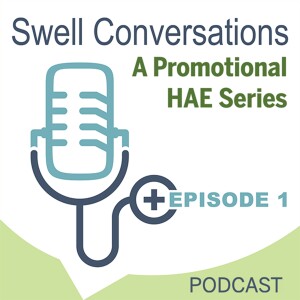
Monday Nov 13, 2023
Simplifying the Science: The Root Cause of HAE
Join esteemed experts John Anderson, MD, clinical assistant professor at The University of Alabama at Birmingham and Partner at AllerVie Health, and Dareen D. Siri, MD, chief executive officer and physician at Midwest Allergy Sinus Asthma, SC in Illinois, as they explore how and why hereditary angioedema (HAE) occurs, including the multifaceted role of C1 inhibitor. They will also provide their clinical perspectives on connecting with patients and engaging ways to communicate the HAE disease mechanism. At the end of the discussion, Drs Anderson and Siri will discuss the mechanism of action for RUCONEST® (C1 esterase inhibitor [recombinant]).
WHAT IS RUCONEST?
RUCONEST® (C1 esterase inhibitor[recombinant]) is indicated for the treatment of acute attacks in adult and adolescent patients with hereditary angioedema (HAE). Effectiveness in clinical studies was not established in HAE patients with laryngeal attacks.
IMPORTANT SAFETY INFORMATION
RUCONEST is contraindicated in patients with a history of allergy to rabbits or rabbit-derived products and for patients with a history of life-threatening immediate hypersensitivity reactions, including anaphylaxis, to C1 esterase inhibitor (C1-INH) preparations.
Monitor patients for early signs of allergic or hypersensitivity reactions (including hives, generalized urticaria, tightness of the chest, wheezing, hypotension, and/or anaphylaxis). If symptoms occur, discontinue RUCONEST and administer appropriate treatment.
Serious arterial and venous thromboembolic (TE) events have been reported with plasma-derived C1-INH products. Risk factors may include the presence of an indwelling venous catheter/access device, prior history of thrombosis, underlying atherosclerosis, use of oral contraceptives or certain androgens, morbid obesity, and immobility. Monitor patients with known risk factors for TE events during and after RUCONEST administration.
Appropriately trained patients may self-administer RUCONEST upon recognition of an HAE attack. Advise patients to seek medical attention if progress of any attack makes them unable to properly prepare or administer a dose of RUCONEST. No more than 2 doses should be administered within a 24-hour period.
The serious adverse reaction reported in clinical trials was anaphylaxis. The most common adverse reactions (incidence ≥2%) were headache, nausea, and diarrhea.
Before prescribing RUCONEST, please read the full Prescribing Information including the Patient Product Information.
DISCLAIMER
This educational program is sponsored by Pharming Healthcare, Inc. The speakers have been compensated for the presentation of this information. The information contained within this podcast is for educational purposes only and is not intended to be medical advice. Patient experiences may be discussed in this episode. It is important to recognize that these experiences may not be representative, as every patient has a unique disease course. This activity is not intended for Continuing Medical Education credits.
EPISODE REFERENCE LIST
- Maurer M, Magerl M, Betschel S, et al. The international WAO/EAACI guideline for the management of hereditary angioedema-The 2021 revision and update. Allergy. 2022;77(7):1961-1990. doi:10.1111/all.15214
- Busse PJ, Christiansen SC, Riedl MA, et al. US HAEA Medical Advisory Board 2020 Guidelines for the management of hereditary angioedema. J Allergy Clin Immunol Pract. 2021;9(1):132-150.e3. doi:10.1016/j.jaip.2020.08.046
- Jacobs J, Neeno T. The importance of recognizing and managing a rare form of angioedema: hereditary angioedema due to C1-inhibitor deficiency. Postgrad Med. 2021;133(6):639-650. doi:10.1080/00325481.2021.1905364
- Rosi-Schumacher M, Shah SJ, Craig T, Goyal N. Clinical manifestations of hereditary angioedema and a systematic review of treatment options. Laryngoscope Investig Otolaryngol. 2021;6(3):394-403. doi:10.1002/lio2.555
- Zanichelli A, Longhurst HJ, Maurer M, et al. Misdiagnosis trends in patients with hereditary angioedema from the real-world clinical setting. Ann Allergy Asthma Immunol. 2016;117(4):394-398. doi:10.1016/j.anai.2016.08.014
- Kaplan AP, Joseph K. Pathogenesis of hereditary angioedema: the role of the bradykinin-forming cascade. Immunol Allergy Clin North Am. 2017;37(3):513-525. doi:10.1016/j.iac.2017.04.001
- Fields T, Ghebrehiwet B, Kaplan AP. Kinin formation in hereditary angioedema plasma: evidence against kinin derivation from C2 and in support of "spontaneous" formation of bradykinin. J Allergy Clin Immunol. 1983;72(1):54-60. doi:10.1016/0091-6749(83)90052-0
- Kaplan AP, Joseph K. Complement, kinins, and hereditary angioedema: mechanisms of plasma instability when C1 inhibitor is absent. Clin Rev Allergy Immunol. 2016;51(2):207-215. doi:10.1007/s12016-016-8555-6
- Andrejević S, Korošec P, Šilar M,et al. Hereditary angioedema due to C1 inhibitor deficiency in Serbia: two novel mutations and evidence of genotype-phenotype association. PLoS One. 2015;10(11):e0142174. doi:10.1371/journal.pone.0142174
- Ruconest. Prescribing information. Pharming Healthcare Inc; 2020.
Comments (0)
To leave or reply to comments, please download free Podbean or
No Comments
To leave or reply to comments,
please download free Podbean App.